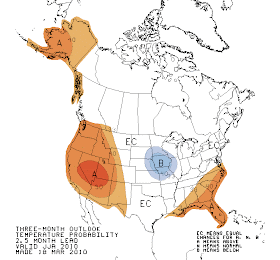
Living here in the Northwest we often think about how much it rains, but to truly understand our weather, you have to appreciate our
rainshadows. We have world-class rain, but we also have world-class
rainshadows. Take a look at the radar image above (from the
Camano Island radar). Precipitation (indicated by the colors) all around the place, but there is a rain-free zone downstream of the Olympics...stretching from
Sequim to the San
Juans. Or take a look at the precipitation over the last six hours from the
SPU Rainwatch System (see graphic). You can see that the dry-zone ground zero is just offshore from
Sequim. That is why so many people retire there and cacti are native species.

As air approaches a barrier it rises, producing precipitation, but on the opposite side there is sinking, drying, and rain shadow creation. You can look at the
rainshadow above and immediately know the wind direction near the Olympics--from the south-southwest. To prove this, here is the latest radiosonde sounding at Forks, on the Olympic Peninsula. The general crest level of the Olympics is roughly 5000 ft--approximately 850
mb, with higher terrain above that to roughly 8000 ft. So look at 850-800 on the sounding chart.

If you can read the wind barbs, you will see the southerly flow.
An important thing to know about
rainshadows is that they can move since their position is controlled by large scale wind direction interaction with terrain barriers. So
Sequim being dry is not religion. It is just the wind here in the winter is typically from the south to southwest. If the large scale wind shifts direction, so will the
rainshadow. So if the wind switches to westerly or northwesterly,
Sequim is no longer effectively shadowed, but Seattle and central Puget Sound is! That will give the retirees and golfers in
Sequim something to think about! Such Puget Sound
rainshadowing is really quite frequent and helps explain why Seattle is really quite dry (only 37 inches a year), receiving far less than the east coast of the U.S., and WAY less than the Washington Coast. That is why vampires live in Forks but keep away from the Puget Sound lowlands.
But there is one ironic complication to our
rainshadow under westerly flow....something that literally rains on our parade: the Puget Sound convergence zone, which produces a band of rain IN THE MIDDLE OF A PROFOUND
RAINSHADOW. That is why north and south of a convergence zone it can be profoundly clear.
Finally, not only can
rainshadows move, but we have lots of them due to our complex mountains. Big
rainshadows in the lee of the mountains of Vancouver Island, the Cascades, the Blue Mountains. Smaller ones in the lee of Mt. Rainier and the other volcanoes. Even
rainshadows int the lee of Queen Anne Hill and Tiger Mountains. Yes, this is really
rainshadow land here.


 10 PM Thursday
10 PM Thursday 10 PM Thursday
10 PM Thursday 10 PM Friday
10 PM Friday This is all very serious. The persistent southeasterly winds are pushing water up against the coast, where the general water levels will be several feet above normal. On top of that there is substantial wave action--roughly 5-7 feet. The only good aspect of all this...and good is a bad word, is that it is moving the spill away from Florida. There is a loop current in the Gulf and if the spill went south, the oil could move along the western side of Florida, into the Keys and the Everglades, and around the peninsula towards Miami. This is the last place in the U.S. you want a major spill.
This is all very serious. The persistent southeasterly winds are pushing water up against the coast, where the general water levels will be several feet above normal. On top of that there is substantial wave action--roughly 5-7 feet. The only good aspect of all this...and good is a bad word, is that it is moving the spill away from Florida. There is a loop current in the Gulf and if the spill went south, the oil could move along the western side of Florida, into the Keys and the Everglades, and around the peninsula towards Miami. This is the last place in the U.S. you want a major spill.















































